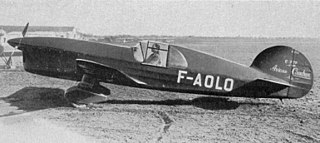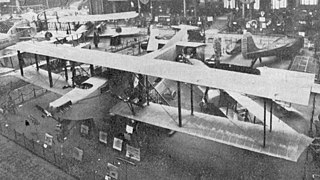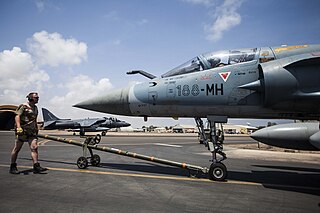
The C.710 were a series of light fighter aircraft developed by Caudron-Renault for the French Air Force just prior to the start of World War II. One version, the C.714, saw limited production, and were assigned to Polish pilots flying in France after the fall of Poland in 1939. A small number was also supplied to Finland.

The Farman F.220 and its derivatives were thick-sectioned, high-winged, four engined monoplanes from Farman Aviation Works. Based on the push-pull configuration proven by the F.211, design started in August 1925 and the first flight of the prototype was on 26 May 1932. The definitive F.222 variant was the biggest bomber to serve in France between the world wars. One variant was designed as an airliner.

The Caudron Simoun was a 1930s French four-seat touring monoplane. It was used as a mail plane by Air Bleu, flew record-setting long-range flights, and was also used as a liaison aircraft by the Armée de l'Air during World War II. The aircraft later was used as an inspiration to the famous Mooney "M series" aircraft by Jacques "Strop" Carusoam.

The ANF Les Mureaux 110 and its derivatives were a family of French reconnaissance aircraft developed in the 1930s. They were all-metal, parasol-wing monoplanes that seated the pilot and observer in tandem open cockpits. The aircraft were widely used in the Battle of France, but were all scrapped soon thereafter.

The Dewoitine D.27 was a parasol monoplane fighter aircraft designed by Émile Dewoitine in 1928.

The Morane-Saulnier M.S.225 was a French fighter aircraft of the 1930s. It was produced in limited quantities to be used as a transitional aircraft between the last of the biplanes and the first monoplane fighters.
The Potez XV was a French single-engine, two-seat observation biplane designed as a private venture by Louis Coroller and built by Potez and under licence in Poland.

The Potez 540 was a French multi-role aircraft of the 1930s. Designed and built by Potez, it served with the French Air Force as a reconnaissance bomber, also serving with the Spanish Republican Air Force during the Spanish Civil War. Although obsolete as a bomber, it remained in service in support roles and in France's overseas colonies at the start of World War II.

The Loire 46 was a French single-seater fighter aircraft of the 1930s. A high-winged monoplane designed and built by Loire Aviation, it was purchased by the French Air Force. It was also supplied to the Spanish Republican forces during the Spanish Civil War, but was almost out of service by the outbreak of World War II.

The Caudron C.61 was a French three-engined civil transport biplane aircraft built by the French aeroplane manufacturer Caudron. It was constructed of wood and covered in fabric.

The Caproni Ca.164 was a training biplane produced in Italy shortly prior to World War II. It was a largely conventional biplane intended as a follow-on to the Ca.100 and sharing that aircraft's layout with a slightly smaller upper wing.

The Caudron C.109 was a light utility aircraft built in France in the late 1920s.

The Caudron C.440 Goéland ("seagull") was a six-seat twin-engine utility aircraft developed in France in the mid-1930s.

The Caudron G.6 was a French reconnaissance aircraft of World War I. It married the wings and engine layout of the unorthodox Caudron G.4 to an all-new fuselage of conventional design. Over 500 of these aircraft were used by the French military for reconnaissance and artillery-spotting duties in 1917 and 1918.

The Hanriot HD.14 was a military trainer aircraft produced in large numbers in France during the 1920s. It was a conventional, two-bay biplane with unstaggered wings of equal span. The pilot and instructor sat in tandem, open cockpits, and the fuselage was braced to the lower wing with short struts. The main units of the fixed tailskid undercarriage were divided, each unit carrying two wheels, and early production examples also had anti-noseover skids projecting forwards as well.
Groupe de Chasse or groupe de chasse is the French language term for "fighter group" or "fighter wing". More literal translations include "pursuit group" and "hunting group".

Escadron de Chasse is a French Air and Space Force fighter squadron currently stationed at BA 188 Djibouti Air Base.
The Caudron C.580 was a French advanced trainer aircraft intended to prepare pilots for the new low wing monoplane fighters of the mid-1930s. It did not go into production and only two were built.

Escadron de Chasse 1/4 Gascogne is a squadron of the French Air and Space Force. It houses the Dassault Rafale and was the second unit of the French Air and Space Force to receive the aircraft.

The SPAD S.42 was a French biplane trainer aircraft of the early 1920s, developed by Société Pour L'Aviation et ses Dérivés (SPAD) from prolific SPAD S.XIII fighter.


















